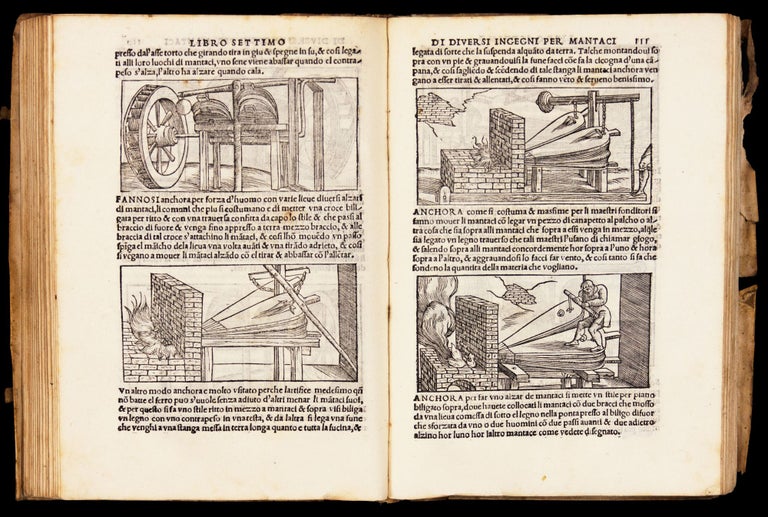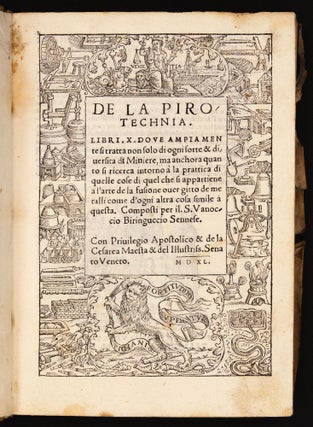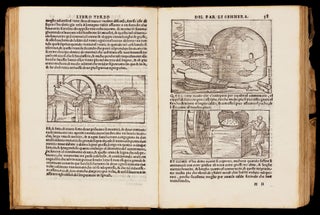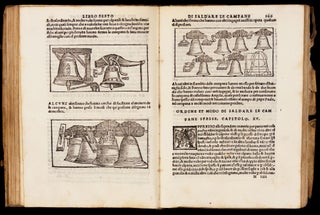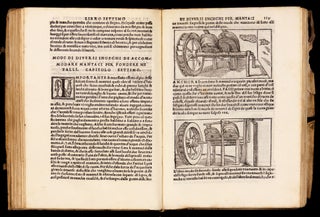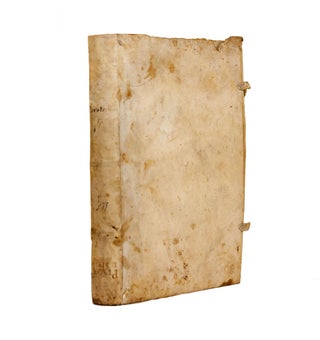De la Pirotechnia. Libri. X. Dove apiamente si tratta non solo di ogni sorte & diuersita di Miniere, ma anchora quanto si ricerca intorno a la prattica di quelle cose di quel che si appartiene a l’arte de la fusione ouer gitto de metalli come d'ogni altra cosa simile a questa.
4to [21.5 x 14.0 cm], (8) ff., 168 ff., title page with a fine woodcut border, (84) woodcut illustrations in the text, woodcut initials. Bound in contemporary limp vellum, title in manuscript on spine, remnants of ties. Minor rubbing, staining, and edge wear to binding, a few non-obtrusive wormholes. Minor marginal staining in the first few quires, occasional very minor staining thereafter, minor marginal loss in last few quires from rodent bite, single marginal wormhole in last few quires. A very appealing copy – large and genuine – of the rare first edition of this famous and influential illustrated book (Dibner, Heralds 38) highly unusual to find in such fresh condition as here. De la Pirotechnia is “the first comprehensive book on the fire-using arts and one of the classics in the history of science and technology” (Hoover, p. 37). The range of subjects treated with great originality include, besides mining and metallurgy proper, organic chemistry, gunpowder, military arts and fireworks. Beyond its seminal influence on these fields, particularly via Agricola’s De re metallica, the work’s effects on founding and casting processes could be felt in the subsequent history of art (sculpture, medallions and decorative ornament) and even the history of printing – it contains the earliest known account of typecasting. The Pirotechnia was intended by Biringuccio as a handbook for practitioners and was built upon trial and error over many years of experience; it is concerned with operations that had been found to work without much regard to why. While he shared some of the same tools and apparatus employed by alchemists of his time, Biringuccio’s chapter on the subject of alchemy shows his disagreement with their general theoretical approach while conceding that practical alchemists have produced a number of useful things. According to Cyril Stanley Smith, “Biringuccio’s evaluation of alchemy is astonishingly modern.” Smith (xv). “Virtually all of Biringuccio’s descriptions are original … [on the art of casting] he is far better than two other sixteenth-century authors with whom he is inevitably compared, Georgius Agricola and Lazarus Ercker … [Agricola’s] famed sections on glass, steel, and the purification of salts are in fact taken nearly verbatim from the Pirotechnia” (DSB, vol. 1, p. 143), and the influence of this work on Agricola and thence on the standard theory and practice of early modern mining and metallurgy and their associated technologies has long been recognized (see, e.g., Lippmann and Partington, “Biringuccio und Agricola,” passim). Notable technological processes described include reverberatory furnaces (illustrated), liquidation of silver from copper by means of lead, bell casting, canon founding, manufacture of steel, and the medical use of gold. Radical innovations include the first mention of blue cobalt, manganese, and the use of sodium chloride for separating gold and silver from baser metals. Stillman’s re-dating of various works ascribed to Basil Valentinus accords the present work priority in the description of antimony (The Story of Early Chemistry, pp. 328-336). Biringuccio (1480-1538/9) entered the service of the ruler of Siena, Pandolfo Petrucci, and after a stint of travel in Germany – then the metallurgical capital of Europe –, was involved in such politically useful activities as the manufacture of guns, gunpowder and counterfeit money. He later served the Dukes of Parma, Ferrara and the Venetian Republic. * Hoover 129; Duveen p. 79; DSB II.143; Dibner, Heralds 38; Philip B110.2; Partington II. pp. 32-37; Mortimer, Harvard, Italian 16th-century Books, 66; E. O. von Lippmann and J. R. Partington, “Biringuccio und Agricola,” Isis, vol 26, no. 1 (1936), pp. 37-38. Smith & Gnudi, The Pirotechnia…. New York, 1943.
Sold

